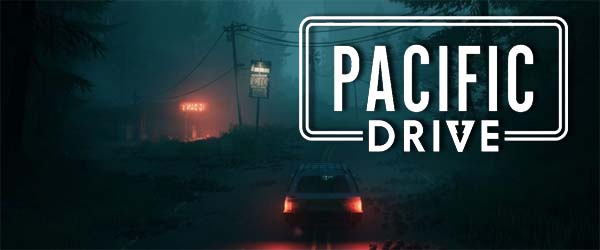
I really enjoyed Pacific Drive, but I admit that I struggled a bit in the early hours. The tutorial is decent, but it's a bit of an information overload, and the player doesn't really get much opportunity to practice certain mechanics so that they sink in.
So I wanted to share some of my tips based on the confusions and growing pains that I experienced, so that other new players can hopefully shorten the learning curve and get to enjoying the game more quickly.
[More]

When I first saw the trailers for Pacific Drive, it was being pitched as a survival horror that takes place entirely in a car. Or at least, that was my takeaway from the initial announcements and teasers. It had me intrigued, such that I immediately wishlisted the game. However, that isn't quite what the game ended up being. Instead, Pacific Drive is more of a survival/crafting/extraction game with light-to-moderate horror elements. There's also an emphasis on logging and cataloguing everything you encounter, which nullifies much of the horror and mystery that it could have, in favor of encouraging exploration and curiosity.
The bulk of the gameplay consists of driving to different parts of the map, scavenging for materials and supplies, and using those materials to craft upgrades for your possessed station wagon. And all the while, you're scanning almost everything you encounter in order to catalogue it (from paranormal phenomena, to resources and equipment, to the different types of wrecked vehicles you find rusting along the roadside, and everything in between). Maybe I misunderstood those initial announcements and teasers. Whether I misunderstood, or the game's concept was poorly communicated, or its design simply shifted over the course of the intervening year or so (which happens), the final game errs much closer to No Man's Sky than to Resident Evil, and might even have tiny hints of inspiration from things like Outer Wilds and Portal.
The crafting focus also means that the gameplay is split almost evenly between driving and scavenging on foot. I'm constantly getting out of the car to search an abandoned building for materials, or using the various tools to break down other wrecked vehicles for their constituent parts. So the idea that the game would be played entirely from within the car also ended up not being the case. In fact, a majority of my opening hours of the game were played on foot, since so much of the early game is a series of tutorials on how to craft various tools and car parts.
Pacific Drive can be serene and beautiful, and almost zen-like.
So Pacific Drive takes a while to really get going. Whether it's the sub-genre-defining horror game that I anticipated, or a more trendy survival/crafting/extraction game with a driving gimmick, Pacific Drive still turned out to be quite good and addicting. In fact, the survival and extraction focus might even have made it a better game than what I was envisioning in my own mind.
Grab 'n' Go
Pacific Drive's core gameplay loop is more akin to an extraction shooter, except that it's single-player PvE (Player vs Environment), and the player uses a possessed, beat-up old station wagon as your primary method of locomotion and eventual escape. You choose an area from a map menu, and the specific details of the area are pseudo-randomized each time you enter (and can change if you return later). You drive around the area, collecting any resources or materials you find, avoiding paranormal hazards, and occasionally finding documents or audio logs that slowly explain what happened to the Olympic Peninsula Exclusion Zone.
But there's also a ticking clock, and this is where the "extraction shooter" influence appears. If you lollygag too long, meticulously avoiding obstacles, and gingerly collecting everything that isn't nailed down, a blaring siren will sound, and a mysterious Fortnite-esque "storm" will slowly engulf the area. If you get caught in the storm, you'll slowly take damage until you either escape or die. And the only way to escape is usually to trigger a warp portal that appears somewhere on the map. These portals can only be activated if you're more than a certain distance away, and once activated, the storm starts to rapidly expand. You have only minutes to drive halfway across the map to the portal and escape, with the storm breathing down your neck.
Each voyage is punctuated by a frantic race to a gateway portal.
[More]
7a4a2b03-cfb0-42a5-88af-2605cfaebb55|6|3.7
Tags:Pacific Drive, Ironwood Studios, Kepler Interactive, car, driving, crafting, survival, horror, extraction, Pacific Northwest, ARDA, science, anomaly, garage, road, forest
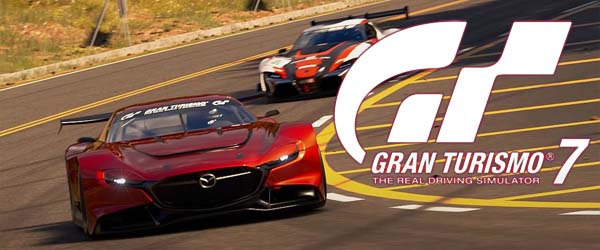
I recently published a video to YouTube explaining how playing Gran Turismo 7's weird campaign reminded me of why I stopped playing Gran Turismo games to begin with. This video is not a full review of Gran Turismo 7, since I don't do video reviews. It's more a retrospective of my history with the franchise, why I chose to buy GT7, and my reaction to the game's campaign and reward structure. Not to mention some obligatory jabs at the game's awful, scammy, and borderline fraudulent bait-and-switch monetization scheme. Even though this isn't a proper review, it does echo much of the content of my original blog review, so I invite you to check that out. And since the review already contains most of the points made in the video, I'm not going to transcribe the entire video in text.
Gran Turismo 7 reminded me why I stopped playing Gran Turismo.
In summary, I have felt that since around Gran Turismo 4, the games have shifted to being more about collecting cars than about actually driving or racing them. Reward cars are given out like candy, leading to a garage full of cars that I never drive and which I don't feel I really earned. There's no attachment or sense of ownership over the cars, and they just don't feel like my cars in the way they did in the first Gran Turismo. That first game required greater investment to win prize cars, making them feel more earned, and it put a greater emphasis on tuning the cars in the garage to get the best performance out of them. Buying my own cars and meticulously tuning them really created that sense of ownership that is just lacking in GT7.
I also want to emphasize that I do not hate Gran Turismo 7. Even though I dislike the campaign and its reward structure, and even though the monetization model is despicable, the actual driving is absolutely fantastic! Especially with the Dual Sense controller on the PS5. I am particularly impressed with how well the Dual Sense's motion controls work for steering the car. There's some nifty haptic feedback features as well, but steering the car with the motion sensor is an absolute game-changer. So the campaign may suck, but I'm still playing GT7 on a regular basis because of how much I enjoy the driving. I've been alternating between GT7 and Elden Ring.

So anyway, I hope you enjoy the linked video. Feel free to share your own experiences with the game in the comments, either here on the blog, or on the YouTube video. And remember, all my content is funded by the support of readers and viewers like you through Patreon. So if you enjoy this content, I hope you'll consider contributing to help support the creation of further content. And if you do decide to join as a Patron, then, first of all: thank you! And secondly, don't forget to fill out the Patreon Entry Survey and tell me what content you enjoy the most. [More]
399a22fb-8511-4ab1-b635-e2dadc105c07|0|.0
Tags:Gran Turismo, Gran Turismo 7, Sony, PlayStation 5, Dual Sense controller, adaptive trigger, motion control, haptic feedback, Polyphony, car, history, racing, driving, steering, collecting, Pokemon, pre-order, micro-transactions, grind, always online, YouTube

I used to love the Gran Turismo games. I played the shit out of Gran Turismo 1-3. I think I was even close to hitting the 100% completion threshold of GT2 (well, the max 98.2% because the game was bugged and it was actually impossible to get to 100%). 1 and 3 in particular are great games in their own right, and still hold up well today. Gran Turismo 4, however, is when the series started to lose me, due to several changes to the design philosophy of the game that all converged to make it less appealing to me as a matter of personal enjoyment.
I was able to get my hands on a fancy new PS5 over the holidays, and I'm looking for games to play on it, and also technical showcases to see what the fancy new hardware can do. I was especially curious how a simulation racing game would feel on the Dual Sense controllers, with its variety of haptic feedback features. I could see a lot of potential in that genre of game. So I bought Gran Turismo 7 for pretty much this reason alone. It was a little bit for nostalgia too. This game celebrates the 25th anniversary of the series itself. So I went ahead and purchased it for old time's sake.
I was even tempted to buy the Special Edition to get the bonus Toyota Yaris. I figured the Yaris is probably the closest I'll come to being able to drive my real-life Toyota Echo within the game. However, I suspected that if Gran Turismo 7 would be anything like GT 4 or GT 5, it would be giving away cash and cars like candy. So I didn't see any value in the other special edition bonuses, like the extra credits. I sure as hell wasn't going to spend $20 for just one virtual car that I would probably race a handful of times for its novelty before switching to more powerful cars.
A Toyota Yaris GR is already available in standard edition, so I don't see any value in the special edition.
But there's already a GR Yaris in the game anyway, so I'm not sure what is so special about the Special Edition car. Besides, the Aqua and Prius look more like my car anyway. In any case, I hate special edition bonuses, and pre-order bonuses, and retailer-specific content. It's such a cynical fucking slap in the face to us consumers to have content withheld from the game unless we buy a specific edition, or buy from a specific vendor.
Feeling the road in my hands
Anyway, I bought the game to hopefully be a showcase for the technical innovations of the PS5. Of all the games I so far own on the system, none of their use of the PS5 controller's tactile features have really lived up to the promise of the Astro's Playroom game that comes included with the PS5. I was hoping that being a Sony-exclusive, flagship title, Gran Turismo would really wow me. It does do some neat things, but I don't know that I would say that it "wow" me.
This game requires finesse with the gas and brake.
I didn't really start noticing the rumble feature effects until I got further into the game and was playing with much more powerful cars. Up until then, the rumble was mostly reserved for if I hit the rumble strips on the side of the road or actually went off the road, or if I lost traction or spun out. But it felt similar to typical video game rumble. When the cars started to get more powerful, however, I started noticing some additional rumble effects. The engine would vibrate the controller a bit more, and I would also feel a soft thud from the middle of the controller whenever the car would shift gears.
The adaptive triggers do a little bit more heavy lifting. The throttle will stiffen up if the car starts to lose traction or if trying to accelerate up a steep incline, especially in inclement weather. Even in ideal conditions, smashing the gas and hitting top speed in a straightaway will also make the controller feel unstable in my hands, sometimes to the point that I'm genuinely afraid that if I turn the steering wheel at all, I'll instantly lose control and spin out.
By the time I feel the car slipping in the rain, it's already too late.
This actually causes me to loosen my grip on the trigger and throttle down, which usually restores some stability to the car. Instead of completely losing control because I have no way to know just how lose my car's hold on the road is, the adaptive trigger helps me to maintain control by signaling that I am throttling too hard. Pulling my foot off the accelerator pedal a little is exactly what I do in real life if I start to feel my car losing its grip on the road (which happens quite often in the gusty winds of Las Vegas), and that instinct is exactly replicated in the game.
More generally, the adaptive triggers make it uncomfortable to jam on the accelerator or the brake, especially for an extended period. It really encourages slowly depressing each trigger in order to better control the acceleration or braking of the car. Again, this mirrors how a real-life car is controlled. This makes all inputs feel much more deliberate and controlled.
Steering can be done with the motion sensor.
9 and 3
The real surprise highlight of playing Gran Turismo with the Dual Sense controller is steering the cars with the motion sensor. I'm not sure if this option was available in Gran Turismo 5 or 6 on the PS3 and PS4, or if it's available on the PS4 version of Gran Turismo 7, but this is a totally new way of driving a video game car for me. And I'm actually genuinely surprised by how well it works. I chose the motion control option after I booted up the game for the first time, thinking it would be borderline unplayable, and I would switch back to the traditional analog stick steering. But holy hell, I actually stuck with it!
The motion sensor is surprisingly responsive and maps reasonably well to the motion of holding a steering wheel at 9 and 3 o'clock positions. Using this control method, and the first-person cockpit camera, I had little-to-no problem keeping my car in a straight line and steering it through corners. I even got a gold medal on all but 1 of the B-1 license tests (and all but 3 of the A-1 license tests) using the motion controls for steering.
Steering with the motion sensor is surprisingly responsive and accurate.
It is a little awkward to hold for longer races. Holding down the throttle and brake triggers can be a little bit uncomfortable, especially if I'm trying to use my middle finger for them. And trying to use other face buttons often results in my car veering a bit. Holding the controller out in front of me (where a real steering wheel would be) can also be tiring after lengthy races. Not being mounted to a dashboard means I can't rest my hands on the controller the way that I would on a steering wheel.
[More]
766fde51-f127-42a2-b7b4-fd18b028443f|1|4.0
Tags:Gran Turismo, Gran Turismo 7, Sony, PlayStation 5, Dual Sense controller, adaptive trigger, motion control, haptic feedback, Polyphony, car, history, racing, driving, steering, collecting, Pokemon, pre-order, micro-transactions, grind, always online, Toyota Yaris, Toyota Echo
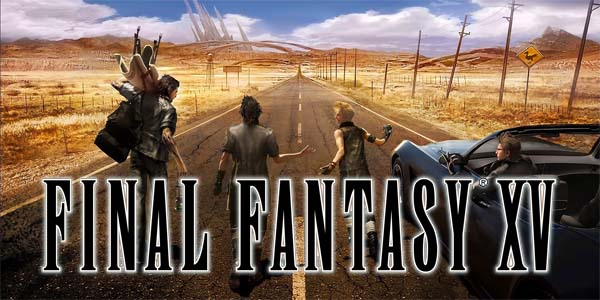
I really don't know what to make of Final Fantasy XV. On the one hand, the game is trying to do something new and kind of interesting with the long-stale open world formula. I desperately want to be able to celebrate the game for these new ideas. That being said, the game just completely blunders so much of its fundamental design, and it tramples on many of these promising new ideas by falling back on too many of the very same tropes that have killed so many other open world games.
The obvious common criticism of the game is that it's got too much of the player just sitting in the car waiting. You don't even have to drive the damned thing, as you can set one of the NPCs in your entourage to do all the driving for you. And even if you do decide to take the wheel, the car drives itself. You just press the gas, and the car automatically steers itself to stay on the road. You can't even turn off of the road even if you want to.
You know what? I'm actually OK with that.
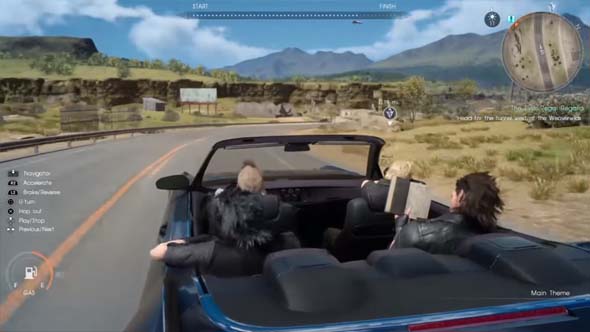
I actually don't mind the long drives, as I can catch up on some reading along with Gladiolus
A nostalgic road trip adventure
You see, having such restrictive travel mechanics actually forces the player to think more about how you're going to navigate the world. While in the car, you are confined to the game's roads and highways. You can't just point the car directly at your objective marker and drive off-road in a straight line to get there. You're also limited to traveling during the daylight hours, and you have to make sure that you budget the time and money to stop for gas and lodgings. There's a genuine amount of logistical planning required for accomplishing virtually any task in this game. You have to think about traversing this world in the same manner that the characters would have to think about it! This is a role-playing game, after all, isn't it? So these travel mechanics are actually pretty clever ways of putting the player in a role-playing mindset and giving you a game to play when you're outside of combat.
I get the feeling that Square-Enix wanted Final Fantasy XV to emulate being on a road trip. You spend large chunks of time sitting in the car driving across the countryside, passing rest stops, scenic overlooks, and roadside diners. You stop every so often to admire the view, take a walk through nature, or chat with the locals. When the sun sets, you are pressured to find a motel to bunk in, or to set up a camp site if you happen to be on foot.
For brief periods of time, this game hits a very serene high in which you start to feel like you're really in this world and with these people, as they sit bored in the car, or eat dinner over a campfire while going over the photos that they took of the day's adventure. It's the same sort of feeling that No Man's Sky hits in its early hours, when you're still awestruck by the sheer size and scope of the new planets you set foot on. Having been someone who used to take annual road trips with my family to visit national parks around the country, seeing a video game try to simulate and systemize that activity (and the human bonding that it engenders) is genuinely endearing and makes me more than a little bit nostalgic.
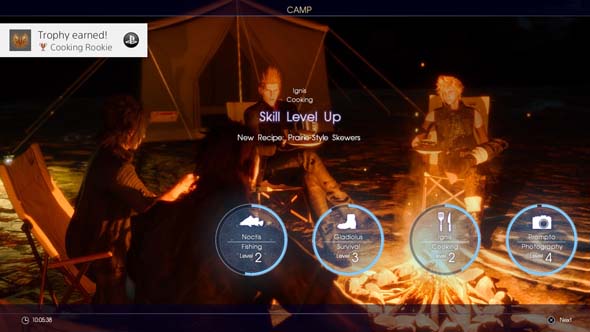
This game makes me nostalgic for the summer camping trips of my youth.
Mundane video game adventure
But then, much like No Man's Sky, Final Fantasy XV shatters that experience by forcing you back into "video game land". It isn't the long stretches of non-interactive driving through a video game vacation that bothers me. Instead, I'm bothered by the sheer tediousness of the mundane fetch quests and busy-work that the game throws at you. You see, a road trip -- and an adventure in general -- only really works if you're always traveling towards a destination. This is a feeling that Final Fantasy X completely nailed!... [More]
8a140761-e4af-4f96-967f-0ee072bf1484|1|5.0
Tags:Final Fantasy, Final Fantasy XV, Square-Enix, RPG, JRPG, open world, road trip, camping, Regalia, car, driving, chocobo, Noctis, Ignis, Gladiolus, Prompto, recipe
|

| 12 | | | | | | | 60 | | 11 | | | | | | | 55 | | 10 | | | | | | | 50 | | 09 | | | | | | | 45 | | 08 | | | | | | | 40 | | 07 | | | | | | | 35 | | 06 | | | | | | | 30 | | 05 | | | | | | | 25 | | 04 | | | | | | | 20 | | 03 | | | | | | | 15 | | 02 | | | | | | | 10 | | 01 | | | | | | | 05 |
|